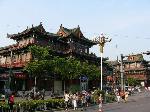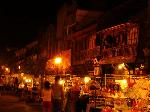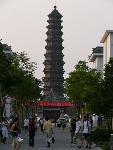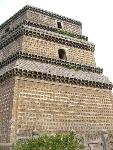- Getting around Lijiang. Dont stay in the Old Towns more than 2 days, there is nothing to do. KRISS Oct 9, 2013 05:46
- 2013 Beijing Temple Fair BENNYLAU Feb 26, 2013 03:29
- Malaysian traveling from KUL - LAX vis Shanghai PVG ZATI_DY Jan 3, 2013 20:15
Kaifeng is Burning
- Views: 7371
- |Vote: 2 0
- |Add to Favorites
- |Recommend to Friends
Too Close to the Sun
Central China burns forcefully in the summer heat, some years worse than others, and during the worst seasons temperatures seem so high that you'd be hard pressed to justify going outdoors. The air around you feels almost solid as the stretching fingers of the sun push against your skin, and your blood thickens to a slow, coagulating simmer. There are hotter places on Earth, sure, but on those bad years there's something just a little more intense here about the sun's pressure and the crowds of densely populated Henan province. You can feel the people going about their determinedly frugal lives in an effort to beat the climate - both meteorological and economic - and persist here on this tough, unhurried, and densely organic land.
It's hard to believe that this place was once a paradise - Henan was the centre of many blossoming and civilised dynasties - and the sites of several ancient capital cities in varying states of modern development and historical preserve remain. Among them, one of the most attractive has to be the city of Kaifeng, right in the province's southeast. It has all the elements of an enchanting venue - ancient structures, including a city wall in reasonable condition; good, moderately clean and broad boulevards bustling with cheerful inhabitants on their industrious way about the place; large parks with lakes and twisting lakeside paths; and accompanying all this - modernised city sectors with 21st century comforts.
I chose one of the worst times to visit Kaifeng. The subcontinent was in the middle of an extreme heatwave that had even killed people from Guangdong to India. I was travelling around Henan and was reduced to doing most of my sightseeing in the late evenings and at night. Riding on the train from Henan's capital city of Zhengzhou to Kaifeng, although it had only taken a couple of hours, had been excruciating, the carriages crammed with blocks of hot air that would not shift, and the passengers sluggishly circulating the train like floating clods of tofu in a soupy hotpot.
Lost in History
I was pleased to arrive in Kaifeng, though. I'd skipped it on a previous journey and had always regretted it - reports from other travellers were always so appealing. Kaifeng itself has an intriguing part in the history of China, and at its height as the capital of the Northern Song Dynasty from 960 to 1127AD was an exceptionally civilised city with a burgeoning artistic and literary culture. My background's in literature, so I get enthusiastic about these locations that place a high value on the efforts of the mind - and despair at how easily they are taken away by the sword. In 1127 the city was captured by Jurchen invaders who tore it all down. Treasures were taken that didn't belong to men of war; the greatest thoughts of the philosophers of the time were dishonoured and burnt to soot. What remained of the city was washed away by the frequently flooded Yellow River, leaving little of the light of this brief period of human invention and imagination to shine on the generations succeeding it. That which is won in battle is nothing as precious as that which is lost in battle.
One other quite unusual episode of Kaifeng's story in Chinese terms is the settlement and subsequent flourishing of a colony of Jews who chose Kaifeng as the place to make a new future. Although it's not certain when exactly they arrived, they were a naturalised part of Kaifeng's community for at least a thousand years - and like Jews across the world, preserved their language and cultural traditions through the ages. Just 156 years ago the entire community and their synagogue too fell victim to flooding - the Yellow River's iniquitous swells have been responsible for many such extinctions throughout history. Today, many Kaifeng residents can trace their ancestry back to Jewish forebears, and some have begun to revive the practices of their heritage. For Jewish tourists who are also China enthusiasts, visiting Kaifeng is something of a pilgrimage.
Bianjing in the Evening
I was looking forward to cheap accommodation in the city, as my guide material had reported - quite correctly - that the local police have no problem with foreigners staying in budget hotels. That being said, finding a room with air-conditioning was even more essential than staying within my fast-disappearing budget. Fortunately for my wallet, several traveller's hostels just across from the railway station had good rooms with private showers and cold, cold air for just RMB 50 a night. I wasn't about to try walking any farther than across the road, and the breeze from the conditioner was so divine that my first afternoon in Kaifeng was spent right in that room.
Don't forget that this was an exceptionally hot year - when I left the hotel in the fading afternoon light, temperatures had dropped to the kinds of levels Kaifeng usually enjoys in the summer - still hot, yes, but quite bearable. I found a bus stop and took route 10 headed for Bianjing Road (Bianjing is Kaifeng's ancient name), one of Kaifeng's main thoroughfares and right in the centre of town. The bus chugged through the restored gate through the city's south wall, and took a nice turn along the edge of Baogong Hu, a smart and well-kept lake with a brilliantly lit Song Dynasty style temple visible in the distance on its shore - the temple is a tribute to a famous judge in Song times who was unwaveringly just.
Authenticity in the Marketplace
I was pretty hungry, and headed for the first restaurant I saw as I got off at the number 10 stop - a classy Islamic 'Qingzhen' joint that was so good I made a special effort to return there later in my stay. I ate gluttonously, which left me in a poor state to sample Kaifeng's signature peanut cakes half an hour later as I was heading for Kaifeng's night markets a little to the west on Shudian Street.
I wasn't sure what to make of the place. I know that Kaifeng has been putting special efforts into developing its reputation as a prime tourism spot - too many travellers pass it by as had I originally - and so as I strolled the lane holding the markets I wasn't sure how to interpret the exquisite Qing Dynasty storefronts along the way. They looked really authentic - most reconstructions I've seen mimic a standard with few variations, but these designs were unique and unusually detailed - were these real? In any case, they were the perfect backdrop for the raucous markets, buzzing in the amber lantern light. I don't usually see anything I like in such markets - the cheap clothing is rarely stylish, and the other trinkets are usually junk - but these stalls had some great merchandise, much of which is made locally and therefore exclusive to Kaifeng. I browsed some hand-painted items and admired the quality as well as the unique craftsmanship, and remembered that I was standing on the ground where a thriving intellectual and creative culture was once lost, and fantasised that with Kaifeng's growing prosperity, perhaps this soil would bring forth that light again.
The Iron Tower
Perhaps my luck was changing. Mercifully, my next morning in Kaifeng was under cool and clement weather - that shocking heatwave was letting off and under regular sunshine, Kaifeng was sparkling. I was delighted, because the relative cool would give me the opportunity to see a couple of the city's ancient towers. They’d stuck in my head since seeing a model of ancient Kaifeng in the Zhengzhou Museum on which the towers had been clearly visible - and I'd quite liked the thought that I'd be able to visit those very towers when I arrived in Kaifeng as it is today.
Tie Ta, or the Iron Tower, is right in Kaifeng's northeast, in a park behind Henan University. The bus route I took differed from the one shown on the map, entailing a shortcut through the university to see the tower - which I was lucky to see, as Henan University is a beautiful campus that has preserved a lot of its traditional buildings. The entrance to the park is right at the university gates, and the tower is clearly visible just metres away - a very distinctive pagoda, it dates right back from the Northern Song period and has a dark, slightly amber hue that earns it its name. It has a slight lean, thanks to the fact that damp soil has seen it slowly sink into the ground - the entire lower level is buried.
Despite being so tantalisingly close, the entrance ticket to the park, in addition to the cost of climbing the tower, seemed so unreasonable that there didn't appear to be any shame at all in enjoying the tower from the short distance away I'd been able to get for free. China's tourist destination prices were hiked up a couple of years ago in an attempt to use the market mechanism to limit annual visitors - in my case, a move that was entirely successful.
Entering History in Po Ta
The much more intriguing Po Ta is on a friendlier scale, and is a short walk from the Train Station - although not so easy to find, and a surprising amount of residents who look as if they've been there all their lives have no idea of how to get there. The housing around the back area of the station is classical Chinese alley courtyard living, walled homes with imposing doors opening out onto winding streets. The tower, when I finally located it, was a squat, fat, three-storey hexagonal pagoda riddled with hundreds of tiny Buddhas etched into square tiles. A dim stairwell leads up to the top inner chamber encased in the thick rock shell of the tower, where all the inner walls are similarly carved with hundreds of little gods (finding tiles that are not Buddhas pique the curiosity - I found one that I could have sworn was someone's dog) and little windows offer an unspectacular view over the area. What's cool about the tower is that at 1,009 years old it's the eldest in the city, and what's more used to have another six storeys on top - the legend goes that an invading leader had the top dismantled to dishonour the previous ruler. A miniature reconstruction of the missing levels sits oddly on its roof like a rock nipple.
I had to leave Kaifeng that evening, and needed to go back and prepare, but was hesitant to leave Po Ta. Maybe it was the fact that I was starting to get the vibe of sitting inside a thousand year old room, adding my own presence as an insignificant detail to its already colourful history. Perhaps more to the point, it was getting hot outside again, and metre-thick rock is a fairly good protection from the heat. Perhaps in this way Kaifeng's ancient inhabitants might have taken refuge from their own unbearable summers too.









 Copyright © 1998-2025 All rights reserved.
Copyright © 1998-2025 All rights reserved.
1.
Mar 8, 2006 00:12 Reply
LITTLETREE said:
Amazing artical and experience. I have been there for two weeks but seldome have this kind of feeling. Kaifeng is a magical city. You are also recommended to read an article named "From New York to Kaifeng".Amazing articles!